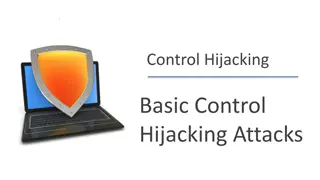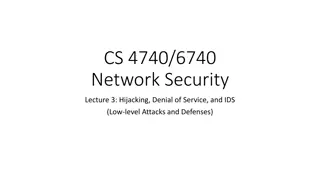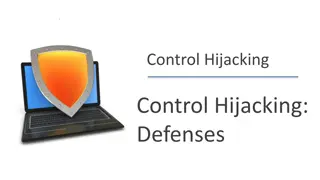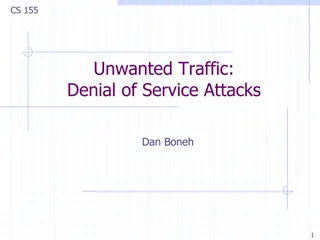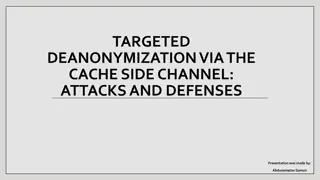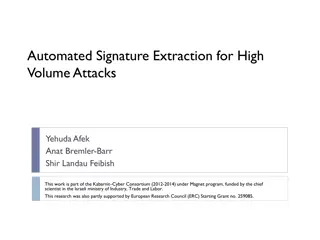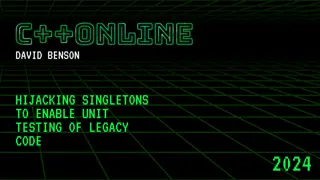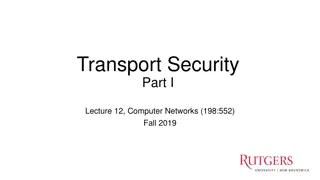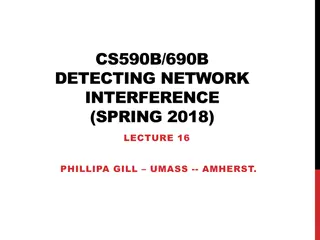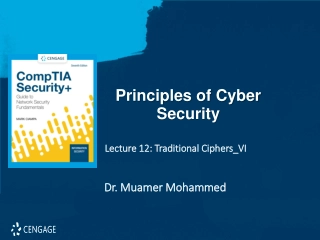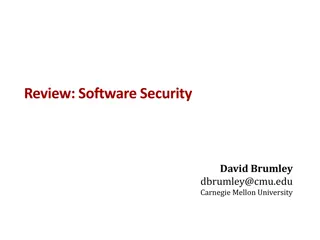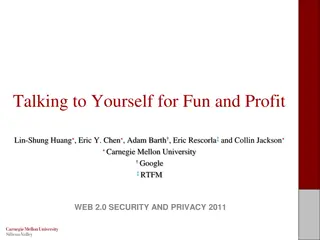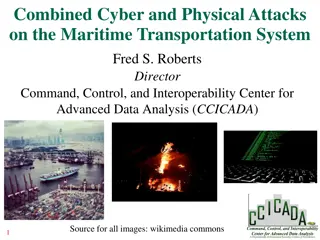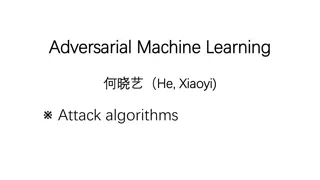Understanding Control Hijacking Attacks in Computer Systems
Explore the concept of control hijacking attacks in computer systems, including buffer overflows, format string vulnerabilities, and use-after-free exploits. Learn about the attacker's goal, examples of attacks, and the importance of understanding C functions, the stack, and the heap. Delve into system calls, CPU and OS considerations, and the layout of process memory in Linux. Gain insights into stack frames and the risks posed by buffer overflows in applications.
Download Presentation

Please find below an Image/Link to download the presentation.
The content on the website is provided AS IS for your information and personal use only. It may not be sold, licensed, or shared on other websites without obtaining consent from the author. Download presentation by click this link. If you encounter any issues during the download, it is possible that the publisher has removed the file from their server.
E N D
Presentation Transcript
Announcements: Project 1 is out: part I due Apr. 13. Please come to section on Friday at 11:30am Control Hijacking Basic Control Hijacking Attacks Dan Boneh
Control hijacking attacks Attacker s goal: Take over target machine (e.g. web server) Execute arbitrary code on target by hijacking application control flow Examples: Buffer overflow and integer overflow attacks Format string vulnerabilities Use after free Dan Boneh
First example: buffer overflows Extremely common bug in C/C++ programs. First major exploit: 1988 Internet Worm. Fingerd. Whenever possible avoid C/C++ Often cannot avoid C/C++ : Need to understand attacks and defenses Feb. 2024: White House support for memory safety Source: web.nvd.nist.gov Dan Boneh
What is needed Understanding C functions, the stack, and the heap. Know how system calls are made The exec() system call Attacker needs to know which CPU and OS used on the target machine: Our examples are for x86-64 running Linux or Windows Details vary slightly between CPUs and OSs: Stack Frame structure (Unix vs. Windows, x86 vs. ARM) Little endian vs. big endian Dan Boneh
Linux process memory layout (x86-64) 0x0000 7FFF FFFF FFFF (128 TB) user stack %rsp (stack pointer) (esp in 32-bit mode) shared libraries 0x0000 7F1F6 XXXX XXXX run time heap Loaded text and data from executable 0x0000 0000 0040 0040 0 unused Dan Boneh
Stack Frame high arguments return address stack base pointer rbp exception handlers Stack Growth local variables callee saved registers rsp low (esp in 32-bit mode) Dan Boneh
What are buffer overflows? void func(char *str) { char buf[128]; Suppose a web server contains a function: After func() is called stack looks like: strcpy(buf, str); do-something(buf); } argument: str return address stack base pointer char buf[128] rsp Dan Boneh
What are buffer overflows? void func(char *url) { char buf[128]; What if *url is 144 bytes long? After strcpy: strcpy(buf, url); do-something(buf); } argument: str return address stack base pointer Poisoned return address! Problem: no bounds checking in strcpy() *str char buf[128] rsp Dan Boneh
Stack Basic stack exploit high Program P Suppose *url is such that after strcpy stack looks like: Program P: exec( /bin/sh ) (exact shell code by Aleph One) return address When func() exits, the user gets shell ! Note: attack code P runs in stack. char buf[128] low Dan Boneh
Stack The NOP slide high Program P Problem: how does attacker determine ret-address? NOP Slide Solution: NOP slide return address Guess approximate stack state when func() is called Insert many NOPs before program P: nop (0x90) , xor eax,eax , inc ax char buf[128] low Dan Boneh
Details and examples Some complications: Program P should not contain the \0 character. Overflow should not crash program before func() exits. (in)Famous remote stack smashing overflows: Overflow in Windows animated cursors (ANI). LoadAniIcon() Buffer overflow in Symantec virus detection (May 2016) overflow when parsing PE headers kernel vuln. Dan Boneh
Many unsafe libc functions strcpy (char *dest, const char *src) strcat (char *dest, const char *src) gets (char *s) scanf ( const char *format, ) and many more. Safe libc versions strncpy(), strncat() are misleading e.g. strncpy() may leave string unterminated. Windows C run time (CRT): strcpy_s (*dest, DestSize, *src): ensures proper termination Dan Boneh
Buffer overflow opportunities Exception handlers: ( more on this in a bit) Overwrite the address of an exception handler in stack frame. Function pointers: (e.g. PHP 4.0.2, MS MediaPlayer Bitmaps) Heap or stack FuncPtr buf[128] Overflowing buf will override function pointer. Longjmp buffers: longjmp(pos) (e.g. Perl 5.003) Overflowing buf next to pos overrides value of pos. Dan Boneh
Heap exploits: corrupting virtual tables Compiler generated function pointers (e.g. C++ code) method #1 method #2 method #3 FP1 FP2 FP3 vptr data vtable NOP slide shell code Object T After overflow of buf : vptr data buf[256] vtable object T Dan Boneh
An example: exploiting the browser heap Request web page Web page with exploit malicious web server victim browser Attacker s goal is to infect browsers visiting the web site How: send javascript to browser that exploits a heap overflow Dan Boneh
A reliable exploit? <SCRIPT language="text/javascript"> shellcode = unescape("%u4343%u4343%..."); // allocate in heap overflow-string = unescape( %u2332%u4276%... ); cause-overflow(overflow-string ); // overflow buf[ ] </SCRIPT> Problem: attacker does not know where browser places shellcode on the heap ??? data ptr buf[256] vtable shellcode Dan Boneh
Heap Spraying [SkyLined] Idea: 1. use Javascript to spray heap with shellcode (and NOP slides) 2. then point vtable ptr anywhere in spray area NOP slide shellcode heap vtable heap spray area Dan Boneh
Javascript heap spraying var nop = unescape( %u9090%u9090 ) while (nop.length < 0x100000) nop += nop; var shellcode = unescape("%u4343%u4343%..."); var x = new Array () for (i=0; i<1000; i++) { x[i] = nop + shellcode; } Pointing function-ptr almost anywhere in heap will cause shellcode to execute. Dan Boneh
Ad-hoc heap overflow mitigations Better browser architecture: Store JavaScript strings in a separate heap from browser heap OpenBSD and Windows 8 heap overflow protection: prevents cross-page overflows guard pages (non-writable pages in virtual memory) In theory: allocate every object on a separate page (eFence, Archipelago 08) not practical: too wasteful in physical memory Dan Boneh
Finding overflows by fuzzing To find overflow: Run web server on local machine Use AFL to issue malformed requests (ending with $$$$$ ) Fuzzers: automated tools for this (next week) If web server crashes, search core dump for $$$$$ to find overflow location Construct exploit (not easy given latest defenses in next lecture) Dan Boneh
Control Hijacking More Control Hijacking Attacks Dan Boneh
More Hijacking Opportunities Integer overflows: (e.g. MS DirectX MIDI Lib) Double free: double free space on heap Can cause memory mgr to write data to specific location Examples: CVS server Use after free: using memory after it is freed Format string vulnerabilities Dan Boneh
Integer Overflows (see Phrack 60) Problem: what happens when int exceeds max value? int m; (32 bits) short s; (16 bits) char c; (8 bits) c = 0 c = 0x80 + 0x80 = 128 + 128 s = 0 s = 0xff80 + 0x80 m = 0 m = 0xffffff80 + 0x80 Can this be exploited? Dan Boneh
An example void func( char *buf1, *buf2, unsigned int len1, len2) { char temp[256]; if (len1 + len2 > 256) {return -1} memcpy(temp, buf1, len1); memcpy(temp+len1, buf2, len2); do-something(temp); } // length check // cat buffers // do stuff What if len1 = 0x80, len2 = 0xffffff80 ? len1+len2 = 0 Second memcpy() will overflow heap !! Dan Boneh
An example: a better length check void func( char *buf1, *buf2, unsigned int len1, len2) { char temp[256]; // length check if (len1 > 256) || (len2 > 256) || (len1+ len2 > 256) return -1; memcpy(temp, buf1, len1); memcpy(temp+len1, buf2, len2); do-something(temp); } // cat buffers // do stuff Dan Boneh
Integer overflow exploit stats 700 600 500 400 300 200 100 0 1996 1997 1998 1999 2000 2001 2002 2003 2004 2005 2006 2015 2016 2017 2018 2019 2020 Dec. 2020: integer underflow in F5 Big IP if (8190 nlen <= vlen ) // length check return -1; Source: NVD/CVE Dan Boneh
Format string bugs Dan Boneh
Format string problem int func(char *user) { fprintf(stderr, user); } Problem: what if *user = %s%s%s%s%s%s%s ?? Most likely program will crash: DoS. If not, program will print memory contents. Privacy? Full exploit using user = %n Correct form: fprintf( stdout, %s , user); Dan Boneh
Vulnerable functions Any function using a format string. Printing: printf, fprintf, sprintf, vprintf, vfprintf, vsprintf, Logging: syslog, err, warn Dan Boneh
Exploit Dumping arbitrary memory: Walk up stack until desired pointer is found. printf( %08x.%08x.%08x.%08x|%s| ) Writing to memory: printf( hello %n , &temp) -- writes 6 into temp. printf( %08x.%08x.%08x.%08x.%n ) -- difficult to exploit Dan Boneh
Use after free exploits Dan Boneh
High impact security vulns. in Chrome 2015 2020 (C++) 70% due to memory management bugs Dan Boneh
IE11 Example: CVE-2014-0282 (simplified) (IE11 written in C++) <form id="form"> <textarea id="c1" name="a1" ></textarea> <input id="c2" type="text" name="a2 value="val"> </form> Loop on form elements: c1.DoReset() c2.DoReset() <script> function changer() { document.getElementById("form").innerHTML = ""; CollectGarbage(); // erase c1 and c2 fields } document.getElementById("c1").onpropertychange = changer; document.getElementById("form").reset(); </script> Dan Boneh
What just happened? c1.doReset() causes changer() to be called and free object c2 object c2 doSomething doReset doSomethingElse FP1 FP2 FP3 vptr data vtable Dan Boneh
What just happened? c1.doReset() causes changer() to be called and free object c2 object c2 FP1 FP2 FP3 ShellCode vptr data vtable Use after free ! Suppose attacker allocates a string of same size as vtable When c2.DoReset() is called, attacker gets shell Dan Boneh
The exploit <script> function changer() { document.getElementById( form").innerHTML = ""; CollectGarbage(); --- allocate string object to occupy vtable location --- } document.getElementById("c1").onpropertychange = changer; document.getElementById("form").reset(); </script> Lesson: use after free can be a serious security vulnerability !! Dan Boneh
Next lecture DEFENSES Dan Boneh
THE END Dan Boneh
References on heap spraying [1] Heap Feng Shui in Javascript, by A. Sotirov, Blackhat Europe 2007 [2] Engineering Heap Overflow Exploits with JavaScript M. Daniel, J. Honoroff, and C. Miller, WooT 2008 [3] Interpreter Exploitation: Pointer inference and JiT spraying, by Dion Blazakis Dan Boneh


